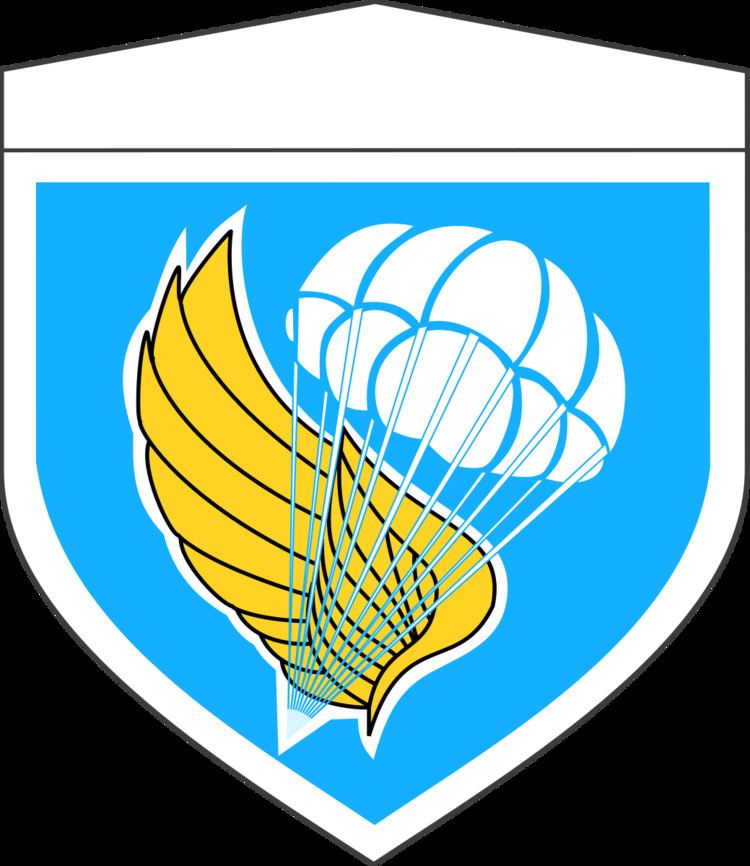Country Japan Size 1,900 soldiers | Type Airborne Infantry | |
 | ||
Active June 25, 1958 – present Role Special operationsAir assaultDirect ActionUnconventional WarfareReconnaissance | ||
The 1st Airborne Brigade (第1空挺団, Dai-Ichi Kūtei Dan), also known as the Narashino Airborne Brigade (習志野空挺団), is stationed in the Japan Ground Self-Defense Force (JGSDF) Camp Narashino in Funabashi, Chiba Prefecture.
Contents
- History
- Firearms Handling
- Iraq War
- Requirements
- Ranger qualification
- Organization
- Weapons
- Local
- Overseas
- Notable personnel
- References
The Brigade serves as Japan's elite paratrooper unit meant to counter against either guerrillas or enemy special forces units. Since 1999 the Brigade has a "Guide Unit" (誘導隊), serving as its NEO (Non-combatant Evacuation Operations) unit. Currently, they are attached to current homeland defense and international combat operations under the JGSDF Central Readiness Force.
The unit is being likened similarly to the WAIR, SFGp, and SBU since these units are Japan's only Special Forces units with an offensive capability. Some of Japan's other Special Forces units are assigned to counter-terrorism or defensive duties. Their presence in the JGSDF has served the organization as a morale booster.
History
In 1958, the Airborne Brigade's first platoon was formed after Hayao Kinugasa was made the first commander of the unit. It continued to increase in numbers as ranger and free-fall training were added in 1962 and 1969. An additional armed transport unit was established in 1973.
In 1985, the 1st Airborne Brigade was involved in rescue operations of the downed Japan Airlines Flight 123 in the ridges of Mount Takamagahara in Gunma Prefecture after the local volunteer fire corps found some survivors, marking the first time that the Brigade was seen in the public eye. Later on, they were also deployed in Yamanashi Prefecture for civil operations and after the Great Hanshin-Awaji earthquake in 1995.
A Guide Unit was established on October 20, 1999, and based at Funabashi, Chiba. Preparations to create a new special forces unit went underway in the Brigade in 2000. In 2003, the framework of the Special Operations Group was established as an anti-guerrilla/terrorist unit embedded in the Brigade, but was established and separated from the Brigade in 2004 and placed under the control of the Defense Agency via the JGSDF like most of the JSDF's special forces units.
Brigade paratroopers were involved in Iraq as the Brigade rotated ground personnel as part of the Japanese government's commitment to Iraq. They were withdrawn alongside the bulk of the Japanese Iraqi Reconstruction Support Group in the middle of 2006. The brigade was added to the Central Readiness Force on March 28, 2007.
On October 9, 2006, members of the Oregon National Guard had a hand in assisting soldiers of the 1st Airborne Brigade in establishing a sniper school to train the unit's first generation of highly skilled snipers during Orient Shield '07.
Firearms Handling
In 1994, Colonel Yasunobu Hideshima was arrested by JGSDF military police officers for violating both the Self-Defense Forces Law and the Firearm and Sword Control Law when he allowed three of his friends to use JGSDF firearms without prior authorization. Lieutenant Colonels Yoshiharu Amano and Michihiko Suzuki were suspended for 20 days for neglect of duty.
Iraq War
Another scandal emerged from within the unit when a 38-year-old 1st Airborne Brigade paratrooper was arrested in Inzai, Chiba Prefecture for shoplifting. He admitted to officers that he did it to demonstrate that he was serious in his effort to avoid deployment to Iraq. When JGSDF officials heard about this, they told press officials that they require the consent of the troopers and their relatives. Otherwise, they would not be deployed. The Iraq deployment had caused a national debate in Japan, and a new public consensus was necessary for the military to develop a modern role and structure.
Requirements
Before joining the 1st Airborne Brigade, all potential candidates must be able to pass the following requirements:
Ranger qualification
1AB paratroopers receive ranger qualification at the end of the brigade's intensive training. The Ranger badge is highly sought by active duty SDF personnel.
Organization
The following structure is as follows:
Weapons
Standard weapons are from the JGSDF, including:
